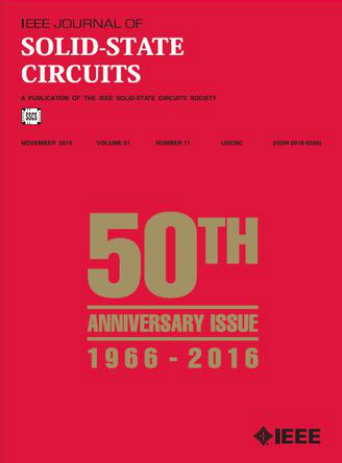一种用于28纳米CMOS存储器接口的64 Gb/s/引脚单端PAM-4发送器及其合并预强调电容峰值串扰消除方案
IF 5.6
1区 工程技术
Q1 ENGINEERING, ELECTRICAL & ELECTRONIC
引用次数: 0
摘要
提出了一种64 Gb/s/引脚单端四电平脉冲调幅(PAM-4)发射机(TX),该发射机采用合并的预强调电容峰值串扰抵消(XTC)方案和3分接可重构分数间隔前馈均衡器(FS-FFE)。提出的XTC方案在不衰减输出摆幅的情况下减轻了远端串扰(ext),同时保持了高TX带宽。所提出的FS-FFE提供了超过奈奎斯特频率的补偿范围,从而减少了切换抖动(SWJ)并延长了PAM-4眼的宽度。可重构前馈均衡器(FFE)分接分配方案使TX能够在更广泛的场景中工作,而无需额外的功耗。此外,预驱动器中的FFE系数选择器消除了FFE抽头通常需要的额外驱动单元,减少了TX输出的寄生电容,并进一步将TX带宽提高了60%。测量结果表明,在64gb /s时,传输效率为1.27 pJ/bit,总插入损耗为- 11 dB, 16 GHz时的频域损耗为- 15.8 dB。所提出的合并c峰XTC方案可将串扰诱发抖动(CIJ)率降低82%。本文章由计算机程序翻译,如有差异,请以英文原文为准。
A 64 Gb/s/pin Single-Ended PAM-4 Transmitter With a Merged Preemphasis Capacitive-Peaking Crosstalk Cancellation Scheme for Memory Interfaces in 28-nm CMOS
A 64 Gb/s/pin single-ended four-level pulse amplitude modulation (PAM-4) transmitter (TX) incorporating a merged preemphasis capacitive-peaking (C-peaking) crosstalk cancellation (XTC) scheme and a 3-tap reconfigurable fractional-spaced feed-forward equalizer (FS-FFE) is presented. The proposed XTC scheme mitigates the far-end crosstalk (FEXT) without attenuating the output swing while maintaining high TX’s bandwidth. The proposed FS-FFE provides a compensation range beyond Nyquist frequency, thereby reducing the switching jitter (SWJ) and extending the widths of PAM-4 eyes. The reconfigurable feed-forward equalizer (FFE) tap assignment scheme enables the TX to operate in a wider range of scenarios without additional power consumption. Besides, the FFE) coefficient selector in the predriver eliminates the need for additional driver cells typically required by FFE taps, reducing parasitic capacitance at the TX output and further improving the TX bandwidth by 60%. The measurement results show that the TX achieves an energy efficiency of 1.27 pJ/bit at 64 Gb/s with a total insertion loss of −11 dB and FEXT of −15.8 dB at 16 GHz. The proposed merged C-peaking XTC scheme decreases the crosstalk-induced jitter (CIJ) ratio by 82%.
求助全文
通过发布文献求助,成功后即可免费获取论文全文。
去求助
来源期刊

IEEE Journal of Solid-state Circuits
工程技术-工程:电子与电气
CiteScore
11.00
自引率
20.40%
发文量
351
审稿时长
3-6 weeks
期刊介绍:
The IEEE Journal of Solid-State Circuits publishes papers each month in the broad area of solid-state circuits with particular emphasis on transistor-level design of integrated circuits. It also provides coverage of topics such as circuits modeling, technology, systems design, layout, and testing that relate directly to IC design. Integrated circuits and VLSI are of principal interest; material related to discrete circuit design is seldom published. Experimental verification is strongly encouraged.
 求助内容:
求助内容: 应助结果提醒方式:
应助结果提醒方式:


